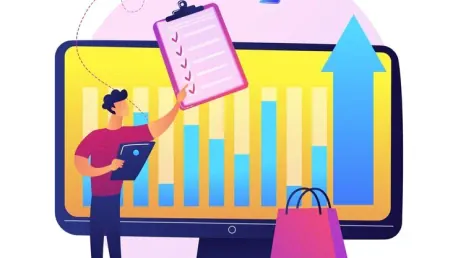Retail analytics has undergone a significant transformation, moving from intuition-based decisions to data-driven strategies. At the core of this shift are sophisticated retail analytics tools that empower retailers to make precise and insightful decisions, ensuring they remain competitive and relevant in an ever-evolving market. As businesses continue to harness the power of data, these analytics solutions play an essential role in helping retailers stay ahead of the curve.
Embracing Data-Driven Strategies
The retail sector is experiencing a major shift toward data-driven decision-making, a transformation driven by the availability of advanced analytics tools. These tools enable businesses to rely on concrete data rather than gut feelings and broad assumptions. Retailers are increasingly looking for actionable insights derived from sophisticated analytics to understand consumer trends, predict future behaviors, and streamline operations.
Such insights are now critical for maintaining a competitive edge, as the market for retail analytics tools continues to grow. With an anticipated investment reaching $31.08 billion by 2032, it is clear that retailers are recognizing the value of comprehensive data analysis in shaping their strategies and improving their overall business performance. Data-driven decision-making has become the cornerstone of modern retail strategies.
Essential Capabilities of Retail Analytics Software
To navigate the complexities of modern retail, the right analytics software must encompass several critical features. Efficient data collection serves as the foundation for retail analytics. Historically, fragmented systems posed challenges for retailers in gathering and utilizing data. However, today’s solutions offer real-time data collection and integration, creating a seamless data flow across various business channels. This capability enables retailers to maintain a centralized database that facilitates more accurate analysis and quicker decision-making.
Moreover, robust inventory management systems are indispensable in retail analytics software. With the high costs associated with storing stock, efficient and unified inventory visibility is paramount. By adopting advanced analytics tools, retailers can generate detailed reports on bestsellers and underperforming items. This leads to the optimization of inventory levels and the enhancement of fulfillment options such as buy online, pick up in-store (BOPIS) and ship-to-home services. Unified inventory management thus becomes a critical component for reducing costs and improving customer satisfaction.
Harnessing Customer Insights
Understanding customer behavior is fundamental to retailer success. Top analytics tools help collect and interpret customer data, offering a comprehensive view of interactions across multiple touchpoints. This holistic perspective allows retailers to glean valuable insights into customer preferences, purchase patterns, and engagement levels, ultimately shaping more effective marketing and sales strategies.
With these insights, retailers can refine customer acquisition and retention strategies, tailoring their approaches to meet the specific demands and preferences of different customer segments. By deploying targeted marketing campaigns, personalized offers, and enhanced customer service, retailers are better positioned to cultivate loyal customer bases and drive long-term growth. The integration of customer data analytics into retail strategies is no longer a luxury but a necessity for thriving in a competitive market.
Mastering Inventory Management
Inventory management is another area revolutionized by retail analytics. The high costs associated with storing stock necessitate efficient and unified inventory visibility. By leveraging advanced analytics tools, retailers can gain a consolidated view of their inventory across multiple channels, including stockrooms, warehouses, and third-party logistics providers. This comprehensive visibility ensures that retailers can effectively manage their stock levels, reduce excess inventory, and minimize stockouts.
Moreover, detailed reporting capabilities enable retailers to identify and analyze the performance of individual products. By understanding which items are bestsellers and which are underperforming, retailers can make informed decisions about inventory replenishment, promotions, and product discontinuation. This data-driven approach to inventory management not only optimizes stock levels but also enhances the overall operational efficiency and profitability of retail businesses.
Real-Time Commerce Insights for Agile Strategies
The fast-paced nature of retail requires agile, up-to-date insights to inform strategic decisions. Modern retail analytics platforms offer rapid and flexible reporting tools, ensuring that retailers can adapt to market dynamics swiftly. These tools facilitate real-time monitoring of sales performance, customer behavior, and operational metrics, enabling retailers to respond promptly to emerging trends and opportunities.
A tool like Shopify Sidekick exemplifies this with its custom data explorations and near-instantaneous surfacing of crucial metrics. This rapid access to pertinent information enhances decision-making processes significantly. Retailers can quickly identify sales trends, assess the effectiveness of marketing campaigns, and adjust their strategies accordingly. The ability to generate real-time insights ensures that retailers remain nimble and responsive in an ever-changing market landscape.
Predictive Analytics for Future Forecasting
Predictive analytics is imperative for anticipating customer needs and fine-tuning business strategies. Advanced tools utilize AI for forecasting, dynamic pricing, and personalization, helping retailers optimize their operations and marketing endeavors. By analyzing historical data and identifying patterns, predictive analytics can accurately forecast future demand, enabling retailers to adjust their inventory levels and staffing plans accordingly.
For instance, analyzing customer preferences for services like BOPIS can guide targeted marketing efforts, driving higher engagement and sales. Predictive analytics can also inform dynamic pricing strategies, allowing retailers to adjust prices in real-time based on factors such as customer demand, competitor pricing, and inventory levels. The ability to anticipate and respond to market changes proactively positions retailers to capitalize on growth opportunities and mitigate risks.
The Importance of Usability and Accessibility
Usability is crucial in ensuring that all levels of staff can effectively interact with and act upon the data provided. Retail analytics tools must offer intuitive interfaces, mobile access, and customizable options to support diverse user needs. When staff across various roles can easily access and understand the data, it fosters a culture of data-driven decision-making throughout the organization.
Platforms like Shopify’s mobile POS app exemplify the integration of usability and accessibility, enabling employees to perform tasks and reference analytics seamlessly. This ease of use ensures that everyone from executives to store associates can leverage the power of data to enhance their performance and contribute to the company’s success. By prioritizing usability and accessibility in retail analytics software, businesses can drive better engagement and more effective use of data at all organizational levels.
Security in Retail Analytics
Given the sensitive nature of the data handled by these tools, robust security measures are required. This includes data encryption, immutable audit logs, user access controls, and compliance with industry standards. Ensuring the security and privacy of customer data is paramount, as breaches can lead to significant financial losses and damage to the retailer’s reputation.
Vendors must continually update their security protocols to protect against breaches, safeguarding both retailer and customer information. Regular security audits, software updates, and employee training are essential components of a comprehensive security strategy. By implementing robust security measures, retailers can ensure that their data remains protected and maintain the trust of their customers.
Leading Retail Analytics Software Solutions
Exploring the top retail analytics tools provides insight into their unique features and pricing, aiding retailers in selecting the most suitable solutions. Shopify Analytics stands out for its integrated analytics across POS and ecommerce, offering real-time insights through a unified platform. This eliminates the need to connect disparate systems, simplifying data management and enhancing the efficiency of data analysis.
Shopify’s ready-made dashboards and customizable reports provide comprehensive insights into sales trends, inventory, marketing effectiveness, and more. By leveraging these insights, retailers can make informed decisions that drive revenue, improve customer satisfaction, and optimize operations. Shopify’s seamless integration and affordability make it a popular choice among retailers looking to implement data-driven strategies effectively.
Feature-Rich Alternatives
Looker is renowned for its robust AI and reporting capabilities, making it a powerful tool for data-driven decisions. While pricing specifics remain undisclosed, Looker’s business intelligence features provide retailers with the ability to generate complex reports and gain deep insights into their operations. This level of analytical power is particularly beneficial for larger retailers with complex data needs.
ThoughtSpot caters to enterprise needs with its AI analyst and extensive app ecosystem. Priced at $1,250 per month, it is designed for organizations that require a high level of customization and scalability in their analytics solutions. ThoughtSpot’s AI-driven insights and user-friendly interface make it an excellent choice for large retailers seeking advanced analytical capabilities.
Innovative Data Visualization Tools
Tableau, from Salesforce, is celebrated for its intuitive dashboards and data visualizations, making it accessible for businesses seeking clear and actionable insights. Priced at $75 per user per month, Tableau allows retailers to create interactive visualizations that simplify the interpretation of complex data. These visualizations help retailers identify trends, track key performance indicators, and communicate insights effectively across the organization.
Microsoft Power BI offers user-friendly reporting tools driven by AI, available from $10 per user per month, with a free plan also available for basic needs. Power BI’s integration with Microsoft’s suite of tools and its robust analytical capabilities make it an attractive option for businesses of all sizes. The platform’s ease of use and affordability enable small and medium-sized retailers to access advanced analytics without a significant investment.
Seamless Integration and Real-Time Alerts
Polar Analytics integrates seamlessly with Shopify, providing real-time alerts and preloaded metrics. Starting at $300 per month, Polar Analytics is designed to address the needs of omnichannel retailers by delivering timely and relevant insights. Its ability to consolidate data from various sources ensures that retailers have a comprehensive view of their operations, enabling informed decision-making.
Triple Whale offers multichannel reporting with advanced AI insights, free for stores processing up to $500,000 Gross Merchandise Volume (GMV) annually. Paid plans begin at $2,990 per year, providing scalability as businesses grow. Triple Whale’s AI-driven analytics help retailers optimize their operations, marketing strategies, and inventory management, making it a valuable tool for data-driven decision-making.
Choosing the Right Tool
Retail analytics has undergone a substantial transformation, evolving from decisions based on gut feelings and intuition to strategies driven by comprehensive data analysis. At the heart of this transformation are advanced retail analytics tools, which empower businesses to make precise, informed decisions, ensuring they remain competitive and relevant in a continuously changing market landscape.
These sophisticated tools enable retailers to delve deep into customer behaviors, market trends, and sales performance, allowing for a more comprehensive understanding of the factors driving their business. By leveraging insights gleaned from vast amounts of data, retail analytics solutions help retailers optimize their inventory, personalize customer experiences, forecast demand, and enhance marketing strategies.
In today’s fast-paced retail environment, staying ahead of the curve is imperative, and data-driven insights are invaluable. As businesses continue to harness the power of data, these analytics solutions play a critical role in shaping the future of retail. They provide a strategic advantage that helps retailers not only survive but thrive amidst the competition. By embracing these analytics tools, retailers are better equipped to meet consumers’ needs more effectively and efficiently.









